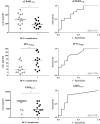BCG and Adverse Events in the Context of Leprosy
- PMID: 29670618
- PMCID: PMC5893643
- DOI: 10.3389/fimmu.2018.00629
BCG and Adverse Events in the Context of Leprosy
Abstract
Background: Notwithstanding its beneficial immunoprophylactic outcomes regarding leprosy and childhood TB, BCG vaccination may cause adverse events, particularly of the skin. However, this local hyper-immune reactivity cannot be predicted before vaccination, nor is its association with protection against leprosy known. In this study we investigated the occurrence of adverse events after BCG (re)vaccination in contacts of leprosy patients and analyzed whether the concomitant systemic anti-mycobacterial immunity was associated with these skin manifestations.
Methods: Within a randomized controlled BCG vaccination trial in Bangladesh, 14,828 contacts of newly diagnosed leprosy patients received BCG vaccination between 2012 and 2017 and were examined for adverse events 8 to 12 weeks post-vaccination. From a selection of vaccinated contacts, venous blood was obtained at follow-up examination and stimulated with Mycobacterium leprae (M. leprae) antigens in overnight whole-blood assays (WBA). M. leprae phenolic glycolipid-I-specific antibodies and 32 cytokines were determined in WBAs of 13 individuals with and 13 individuals without adverse events after vaccination.
Results: Out of the 14,828 contacts who received BCG vaccination, 50 (0.34%) presented with adverse events, mainly (80%) consisting of skin ulcers. Based on the presence of BCG scars, 30 of these contacts (60%) had received BCG in this study as a booster vaccination. Similar to the pathological T-cell immunity observed for tuberculoid leprosy patients, contacts with adverse events at the site of BCG vaccination showed elevated IFN-γ levels in response to M. leprae-specific proteins in WBA. However, decreased levels of sCD40L in serum and GRO (CXCL1) in response to M. leprae simultaneously indicated less T-cell regulation in these individuals, potentially causing uncontrolled T-cell immunity damaging the skin.
Conclusion: Skin complications after BCG vaccination present surrogate markers for protective immunity against leprosy, but also indicate a higher risk of developing tuberculoid leprosy.
Clinical trial registration: Netherlands Trial Register: NTR3087.
Keywords: BCG (re)vaccination; Mycobacterium leprae; adverse events; biomarker profiles; household contacts; leprosy; protective immunity.
Figures




Similar articles
-
Immunological cytokine correlates of protective immunity and pathogenesis in leprosy.Scand J Immunol. 2000 Apr;51(4):419-28. doi: 10.1046/j.1365-3083.2000.00703.x. Scand J Immunol. 2000. PMID: 10736116
-
BCG-induced immunity profiles in household contacts of leprosy patients differentiate between protection and disease.Vaccine. 2021 Dec 8;39(50):7230-7237. doi: 10.1016/j.vaccine.2021.10.027. Epub 2021 Oct 20. Vaccine. 2021. PMID: 34688497
-
Clinical manifestations of leprosy after BCG vaccination: an observational study in Bangladesh.Vaccine. 2015 Mar 24;33(13):1562-7. doi: 10.1016/j.vaccine.2015.02.017. Epub 2015 Feb 18. Vaccine. 2015. PMID: 25701674
-
HLA and leprosy in the pre and postgenomic eras.Hum Immunol. 2006 Jun;67(6):439-45. doi: 10.1016/j.humimm.2006.03.009. Epub 2006 Apr 3. Hum Immunol. 2006. PMID: 16728267 Review.
-
[Identification of an immunodominant antigen of Mycobacterium leprae and its application for the development of protective measures].Nihon Hansenbyo Gakkai Zasshi. 2006 Sep;75(3):279-83. doi: 10.5025/hansen.75.279. Nihon Hansenbyo Gakkai Zasshi. 2006. PMID: 17037384 Review. Japanese.
Cited by
-
Leprosy: A Review of Epidemiology, Clinical Diagnosis, and Management.J Trop Med. 2022 Jul 4;2022:8652062. doi: 10.1155/2022/8652062. eCollection 2022. J Trop Med. 2022. PMID: 35832335 Free PMC article. Review.
-
Leprosy.Nat Rev Dis Primers. 2024 Nov 28;10(1):90. doi: 10.1038/s41572-024-00575-1. Nat Rev Dis Primers. 2024. PMID: 39609422 Review.
-
Blood RNA signature RISK4LEP predicts leprosy years before clinical onset.EBioMedicine. 2021 Jun;68:103379. doi: 10.1016/j.ebiom.2021.103379. Epub 2021 Jun 3. EBioMedicine. 2021. PMID: 34090257 Free PMC article.
-
The safety of BCG revaccination in the context of COVID-19.Hum Vaccin Immunother. 2023 Dec 15;19(3):2271760. doi: 10.1080/21645515.2023.2271760. Epub 2023 Nov 8. Hum Vaccin Immunother. 2023. PMID: 37936434 Free PMC article.
-
The State of Affairs in Post-Exposure Leprosy Prevention: A Descriptive Meta-Analysis on Immuno- and Chemo-Prophylaxis.Res Rep Trop Med. 2020 Oct 15;11:97-117. doi: 10.2147/RRTM.S190300. eCollection 2020. Res Rep Trop Med. 2020. PMID: 33117053 Free PMC article. Review.
References
-
- Global Leprosy Update. 2014: need for early case detection. Wkly Epidemiol Rec (2015) 90(36):461–74. - PubMed
-
- Abubakar I, Pimpin L, Ariti C, Beynon R, Mangtani P, Sterne JA, et al. Systematic review and meta-analysis of the current evidence on the duration of protection by bacillus Calmette-Guerin vaccination against tuberculosis. Health Technol Assess (2013) 17(37):1–372,v–vi.10.3310/hta17370 - DOI - PMC - PubMed
-
- Phillips RO, Phanzu DM, Beissner M, Badziklou K, Luzolo EK, Sarfo FS, et al. Effectiveness of routine BCG vaccination on buruli ulcer disease: a case-control study in the Democratic Republic of Congo, Ghana and Togo. PLoS Negl Trop Dis (2015) 9(1):e3457.10.1371/journal.pntd.0003457 - DOI - PMC - PubMed
-
- Smith SG, Kleinnijenhuis J, Netea MG, Dockrell HM. Whole blood profiling of bacillus Calmette-Guérin-induced trained innate immunity in infants identifies epidermal growth factor, IL-6, platelet-derived growth factor-AB/BB, and natural killer cell activation. Front Immunol (2017) 8:644.10.3389/fimmu.2017.00644 - DOI - PMC - PubMed
Publication types
MeSH terms
Substances
Associated data
LinkOut - more resources
Full Text Sources
Other Literature Sources
Medical

